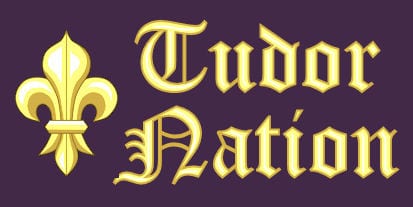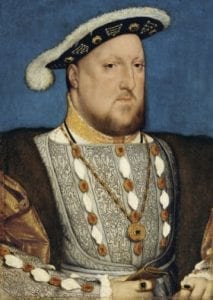A detailed chronology of the main events that happened in 1515 during the reign of King Henry VIII, showing dates, events and details
Events are coded:
Births, Baptisms, Marriages and Deaths
Trials, Imprisonments and Executions
Wars, Battles and Rebellions
Education, Art, Travel and Culture
Property and Possessions
Titles and Appointments
Acts of Parliament
Treaties and oaths
Church and Religion
Births, Baptisms, Marriages and Deaths
Trials, Imprisonments and Executions
Wars, Battles and Rebellions
Education, Art, Travel and Culture
Property and Possessions
Titles and Appointments
Acts of Parliament
Treaties and oaths
Church and Religion
during 1515
Alamain Armoury
This was established at Greenwich to make Henry’s armour. It was called Alamain after the collective name for the Dutch and German craftsmen who were brought to England to work in the armoury. The master armourer was Martin Van Royne and he had a staff of four hammermen, three polishers and one apprentice.
during 1515
New Tiltyard built
Work began on a new tiltyard at Greenwich.
1st January 1515
Francis I became King of France
Following the death of Louis XII the previous day, Henry’s sister, Queen Mary made a formal declaration stating that she was not pregnant. Following this declaration, Francois of Angouleme became King Francis I of France. Like Henry he was fond of sport, hunting and war.
January 1515
Thomas Wolsey leased Hampton Court
Thomas Wolsey leased Hampton Court from the Knights Hospitalers on a 99 year lease. He planned to enlarge and refurbish the palace.
Late January 1515
England and France peace negotiations
Charles Brandon, Nicholas West and Richard Wingfield had been sent to France to negotiate a peace with the new King. Francis stated that he would like the return of Tournai in return for payment of costs Henry had incurred in the taking of the town. The English ambassadors turned this down stating that payment of costs was not sufficient. They demanded that Francis also return all jewels and plate that had been given to Mary while she was Queen of France.
8th February 1515
Thomas Neville Speaker of the Commons
Thomas Neville was elected Speaker of the Commons. His first task was to request personal immunity for all members while in the House to enable them to hold free debates.
February 1515
Archery Law
This Act of Parliament, passed in 1511, was reinforced. It stated that all able-bodied men under the age of 60 years were to keep bows and arrows in their houses and they were to regularly practice with the longbow.
February 1515
Act Concerning Pasture Land
This act ordered that pasture land be converted to tillage and that all decayed houses be rebuilt.
February 1515
Worker’s Pay Act
This act fixed a labourer’s pay at 3 pence per day for winter months and 4 pence per day for summer months, with bonuses to be paid at harvest time. A skilled artisan could expect to be paid 5 pence per day in the winter and 6 pence per day in the summer months. Sundays and Saint’s days were to be days off.
February 1515
House of Commons Register Act
An act was passed which authorised the Speaker of the House of Commons to keep records of attendance, while the clerk of the House was to keep a register of all Members of Parliament.
Mid February 1515
Criminous Clerks Act
This act was introduced as an extension of the 1512 Benefit of Clergy Act and specified that all clerks that commit crimes should be tried in secular rather than ecclesiastical courts. The act was quashed by the House of Lords.
Mid February 1515
Mary and Charles Brandon secretly married
Henry’s sister Mary and Charles Brandon secretly married in Paris. When Henry learned of the marriage he was furious.
5th April 1515
Treaty of Paris
This treaty renewed the peace between England and France made in 1514. The chief English negotiators were Thomas Wolsey, the Duke of Norfolk and the Bishop of Winchester while Peter de la Guiche and John de Selva were the French representatives. Francis I had refused to acknowledge all the terms in the earlier treaty and so new terms had been agreed, namely: A peace to last the lifetime of both Kings; All prisoners of the other country were to be released and allowed to return home; Neither country would harbour the others’ enemies but would extradite them for trial; that each would come to the other’s aid if any invasion was threatened.
Late Spring 1515
Albany returned to Scotland
In contravention of the terms of the Treaty of Paris, Francis I allowed the Duke of Albany to return to Scotland. This act would see Henry’s sister removed as regent of Scotland. Francis wanted to begin a campaign in Italy and knew that if Albany returned to Scotland Henry would be occupied with Scotland and unable to mount an invasion of France.
May 1515
Mary and Charles Brandon allowed to return
The Duke and Duchess of Suffolk were allowed to return to England. Henry agreed to forgive them on condition that they pay him £1,000 per year until Mary’s dowry of £24,000 was repaid. They were also instructed to remarry on English soil. In England they made their home at the Suffolk country house of Westhorpe.
7th May 1515
Trade deal with the Netherlands
Thomas More, Cuthbert Tunstall, Richard Sampson, Thomas Spinelli and John Clifford were sent to the Netherlands to negotiate terms for a trade deal between the countries.
May 1515
Utopia – Thomas More
While in the Netherlands, Thomas More began writing a book which he would later call ‘Utopia’.
18th May 1515
Albany returned to Scotland
John Stewart, Duke of Albany, returned to Scotland. He was escorted to Edinburgh where he demanded that Margaret Tudor hand over her sons James V and Alexander Duke of Ross. Margaret refused and shut herself and her children in Stirling Castle.
Summer 1515
Catherine of Aragon Pregnant
Catherine of Aragon announced her fifth pregnancy. However, less hope was placed on it than before.
10th July 1515
Albany regent of Scotland
The Duke of Albany was officially created Regent of Scotland.
July 1515
Margaret Tudor asked Henry for help
As Albany prepared to lay siege to Stirling Castle, Margaret Tudor wrote to Henry begging him to come to her aid. Her husband had left her to fend for herself and she had no support.
4th August 1515
Stirling Castle under Siege
Albany placed Stirling Castle under siege. He had a force of around 7,000 men and Margaret had no choice but to surrender. Margaret was escorted to Edinburgh Castle while her two sons were left at Stirling Castle in the care of the Lord Fleming, Lord Borthwick and the Governor of the castle Lord Erskine. Albany took up residence in Holyrood House. He did not want to be in the same residence as the two princes for fear of being accused of poisoning should one or both of them die.
Late August 1515
Margaret escaped from Edinburgh
Margaret Tudor, who was heavily pregnant with Archibald Douglas’s child, escaped from Edinburgh. She was helped by her husband, his brother George Douglas and Lord Home. She was taken to Blackadder Castle near the English border where she awaited permission from her brother to enter England.
10th September 1515
Thomas Wolsey elected Cardinal
Thomas Wolsey was elected to the Cardinalate in Rome.
30th September 1515
Margaret Tudor escaped to England
Margaret had finally received permission to enter England. She crossed the border and travelled to Harbottle castle near Otterburn in Northumbria which was owned by Lord Dacre.
7th or 8th October 1515
Birth of Margaret Douglas
A daughter, Margaret, was born prematurely to Margaret Tudor and Archibald Douglas after a long and difficult birth. The child thrived though Margaret was left weak and sickly following the birth.
25th October 1515
Mary Rose Launched
A new galley, ‘The Mary Rose’ was launched. The King attended the ceremony accompanied by his wife and sister. The new galley could carry one thousand men, had 120 oars and 207 guns. After the launching ceremony a banquet was held on board the ship.
15th November 1515
The Cardinal’s Hat Arrived
The Papal ambassador, Worcester, arrived in London bearing the red cardinal’s hat for Thomas Wolsey. The hat was carried, in procession to Westminster Abbey and placed on the high altar where it would remain until the initiation ceremony.
18th November 1515
Wolsey Invested as Cardinal
Thomas Wolsey travelled in procession from York Place to Westminster Abbey where he was invested as Cardinal by William Warham.
22nd December 1515
Wolsey created Chancellor
Thomas Wolsey was appointed Chancellor of England after William Warham resigned to spend more time in his see.
18th December 1515
Death of Alexander Duke of Ross
While convalescing at Harbottle House, Margaret received the news that her younger son Alexander had died.
Published April 4, 2024 @ 3:22 pm – Updated – Dec 09 2024
Harvard Reference for this page:
Heather Y Wheeler. (2024 – 2025). Henry VIII Chronology 1515 Available: http://www.tudornation.com/henry-viii-chronology-1515 Last accessed April 15th, 2025

